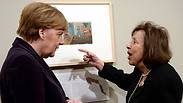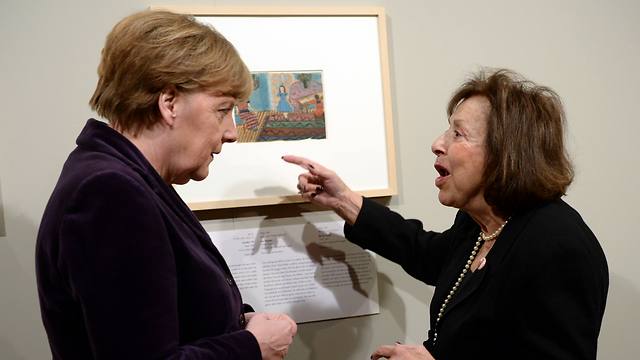
Angela Merkel with artist Nelly Toll
Associated Press
Exhibit of Jewish artists' Holocaust works opens in Berlin
A hundred artworks created by Jewish artists during the Holocaust have gone on display in Berlin, the first time the collection from the Yad Vashem memorial in Jerusalem has been shown outside Israel.
Nelly Toll was only 8 years old when she and her mother went into hiding in 1943 in Poland to escape the Nazis' death camps. The Jewish girl spent long hours in her tiny hideaway at a Christian family's home writing stories, keeping a diary and creating wonderful, bright paintings of a lost world.
Today, her art is on display in the center of Berlin at a special exhibition of Art from the Holocaust that opened at the German Historical Museum on Monday.

Artist Nelly Toll, right, talks to German Chancellor Angela Merkel as Merkel inaugurates the exhibition 'Art from the Holocaust - 100 works from the Yad Vashem collection' in the German Historical Museum in Berlin. (Photo: AP) (Associated Press)
"I hope that generations to come will look at this and know what atrocities made me do this," Toll told The Associated Press at the opening.
Toll's paintings are among 100 artworks created by Jewish artists during the Holocaust on display, the first time the collection from the Yad Vashem memorial in Jerusalem has been shown outside Israel.
The exhibition includes work by Jewish artists in hiding, in concentration and labor camps, and in ghettos. Of the 50 artists featured, 24 were killed by the Nazis. Alongside the mostly unknown names are acclaimed artists such as Felix Nussbaum and Ludwig Meidner.
Toll is the only artist represented in the show who is still alive. One of her paintings, "Girls in the Field," shows two girls, dressed in bright blue, red and yellow-dotted dresses walking across a sunny lawn confined by lush green trees.
"I made 60 paintings while in hiding and all of them express happiness," said Toll, who lost her father and brother in the Holocaust. She immigrated to the United States with her mother after the war.
Like many Jews who created art while being surrounded by death, fear and suffering, painting was a way for Toll to break free and escape from the Holocaust's harsh reality to imaginary places of beauty and happiness.
"I would have conversations with the characters in my paintings for hours," Toll remembered.
However, not all the works show an escape into a happy imagination.
Some artworks are shocking in their depictions of life in the ghetto, daily discrimination and fear of being killed by the Nazis.
Halina Olomucki's 1939 pencil work "After the Shearing of the Beards" shows two orthodox men with bandages around their heads after their beards had been torn or burned off by Germans in the Warsaw ghetto.
Leo Haas' "Transport from Vienna" shows the arrival of a train full of elderly Jews at the Theresienstadt ghetto in 1942. Painted in dark, monochrome India ink, people with faces like hollow skulls can be seen tumbling out of cattle cars, many lying lifeless on the ground as a soldier keeps pulling more people off the train.
The show's curator, Yad Vashem's Eliad Moreh-Rosenberg, called the creation of art during the Holocaust an "uncompromising act of resistance" by artists in mortal danger.
It was very difficult for the artists to get painting supplies, but despite that and their appalling living conditions they managed to portray life during the Shoah, fighting their dehumanization by the Nazis and leaving behind painted witness accounts, Moreh-Rosenberg said.
Among the most touching works is a postcard painted in 1941 by both Karl Robert Bodek and Kurt Conrad Loew while at the Gurs camp in southwestern France, which was then under the Vichy regime that collaborated with the Nazis.
Titled "One Spring," the watercolor shows a bright yellow butterfly sitting on top of black barbed wire, free to fly wherever it desires, while the two artists were confined to the dark barracks of the camp depicted at the bottom of the painting.
Bodek was killed a year later in Auschwitz-Birkenau, while Loew survived and died in his birth city of Vienna in 1980.
German Chancellor Angela Merkel was to officially inaugurate the show on Monday night. It will run through April 3.










